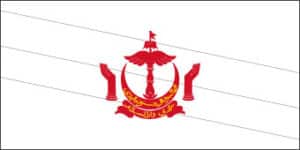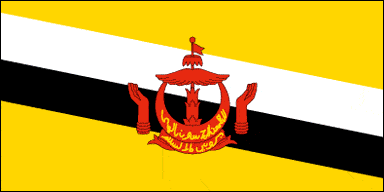
Since 1906, when Brunei became a British protectorate, the country’s present official flag has been flown. After the Constitution of September 29, 1959, was ratified, the crest on the flag was added in 1959.
The official flag of Brunei has a yellow background with white and black bars that cross it diagonally. The red coat of arms for Brunei appears in the middle of the flag.
The proportion of the flag is traced as 1:2. The yellow color signifies liberality while the white color stands for morality and peace.
The crescent on the flag is a symbol of Islam. Below the crescent is a ribbon. The crescent and ribbon have Arabic inscriptions which translate to “State of Brunei, Abode of peace” and “There is no deity but God, Muhammad is the messenger of God”.
Facts about the Brunei flag |
| Country | Brunei |
|---|---|
| Designed by | Unknown designer |
| Adopted | September 29, 1959 |
| Revision | 1906, 1959 |
| Design and Colors | The crest of Brunei is in the center, on a yellow field cut by black and white diagonal stripes (parallelograms). |
| Size Ratio | 1:2 |
| Official Name: | Nation of Brunei, the Abode of Peace |
| Proportion: | 1:2 |
| Adopted on: | September 29, 1959 |
| Location: | Located in south-east Asia on the north coast of the island of Borneo |
| Capital City: | Bandar Seri Begawan |
| Major Cities: | Belait, Temburong, Tutong |
| Area: | 2,226 square miles |
| Population: | 401,890 |
| Currency: | Brunei dollar (BND) |
| Official Language: | Bahasa Melayu |
| National Anthem: | God Bless the Sultan |
Historical Background
The current design of the Brunei flag was officially adopted on September 29, 1959, following Brunei’s independence from British protection. The flag’s design reflects the country’s Islamic heritage and its ties to its ruling monarchy.
Design and Colors
The Brunei flag features a yellow field with two diagonal bands of white and black running from the upper hoist side to the lower fly side. In the center of the flag, there is a red crest featuring the national emblem.
Symbolism of the Brunei Flag
The yellow color represents the Sultan of Brunei, as it is traditionally associated with royalty and authority. The two diagonal bands of white and black symbolize the country’s Islamic faith, with white representing purity and peace, and black symbolizing the country’s independence and strong national spirit.
The red crest in the center features the national emblem, known as the “Pencakar Langit” or “Ukiran Dara Mulia,” which depicts the royal parasol flanked by two upturned hands, symbolizing the country’s protection under the monarchy.
Brunei National Day
Brunei National Day is celebrated on February 23rd each year, commemorating the day in 1984 when Brunei gained complete independence from the United Kingdom. This day is marked by various celebrations, parades, and flag -raising ceremonies, showcasing the importance of the Brunei flag as a symbol of independence and national identity.
FAQs
Q1: When was the current design of the Brunei flag adopted?
The current design of the Brunei flag was officially adopted on September 29, 1959, after Brunei gained independence from British protection.
Q2: What do the colors on the Brunei flag represent?
Yellow represents the Sultan of Brunei and royalty, white symbolizes purity and peace, and black represents independence and the national spirit.
Q3: What is the significance of the red crest on the Brunei flag?
The red crest features the national emblem, known as the “Pencakar Langit” or “Ukiran Dara Mulia,” which depicts the royal parasol flanked by two upturned hands, symbolizing Brunei’s protection under the monarchy.
Q4: What is Brunei National Day?
Brunei National Day is celebrated on February 23rd each year, commemorating the day in 1984 when Brunei gained full independence from the United Kingdom.

